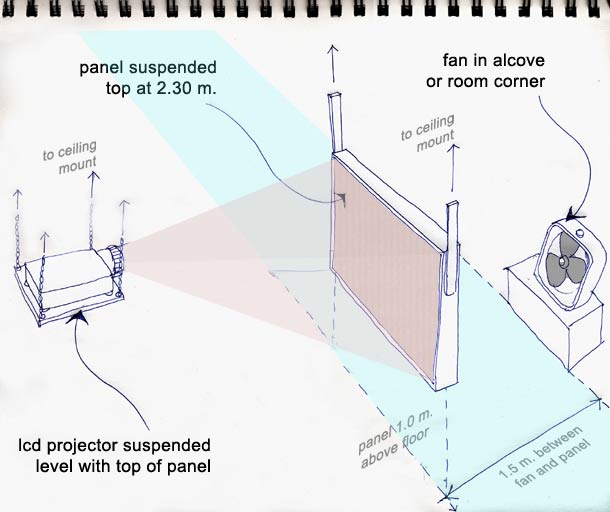Windscreen is an experimental, wind-driven physical interface. My work as a media artist is broadly an investigation of synthetic spatial experience. I use synthetic in the bio(zoo)logical sense- as a structure "usually found in discrete genera, species, or higher groups". For me, this is a conceptual space that allows for cross- fertilization across historical, cultural, and material natures. Despite the many prototypes for "interactive space", it is painfully clear (especially to artists themselves) that even the most advanced sensing-actuation loops are actually very low bandwidth- compared to bodily immersion in a space, for example (noted by David Rokeby and others). Any physical scale habitable by the human body is also "inhabited" by massive levels of sensory data, equivalent to thousands of analog-to-digital inputs a second. My response, in an installation context, was to look for alternative modes of sensing, other energetic or eloquent forces. After all, interactivity does have a long history of means- beyond computing, electronics or even electricity. This experimental approach became an installation work that I call windscreen. Here, much technology was wilfuly discarded, and replaced with a singular, anomalous force - wind. Wind has a checkered history in the arts, Kinetic art and wind-driven "yardart" being well known examples. In the "media arts', it has been intremittenty used, most often metaphorically. I wanted to project this natural force into an imminent future- of "artificial" environments and experiences. In windscreen, wind is no longer a chance vector determined by atmospheric conditions. It is a deliberate environmental act, a sensor and actuator rolled into one. In this work the "virtuality" of a moving projection is made to collide with the physicality of a fluttering surface. A “user” controls this almost physical image by body-blocking the wind. In an inexact way, since the wind-shadow is much less precise than a light shadow. Yet, the relationship is immediate enough to engage the user, who in turn becomes implicated in the image/frame, and is watched by the rest of the audience. The result, to me, was compelling proof that simple, low-tech methods could create effective interactive experience. Several people in the audience (at a gallery show in March 2002), felt that windscreen was an effective critique of the numerous motion tracking, “body shadow” projects that are a familiar sight in media art. > WINDSCREEN VIDEO 1:48 .quicktime windows media player. The projected image is a slowly moving sequence of hard edged color washes that fade into black at every loop. I chose the colors of human races, ie. white black brown yellow red and blue (from the blue men!), because the user would get "painted" a certain color when the projection got through. This a sustained, slowly shifting color field that brings out the detail of the "pixel" action. The visual and auditory effect is a bit like a Rothko being gently slashed over and over- and you see the perpetrator in the back being splattered with its blood. :) The space of windscreen is filled with other (anachronistic?) associations. One person told me it felt like walking past a seaside window in Greece with the blinds moving in the breeze (clearly a personal view). In this case, the sound- a straightforward product of the mechanics and materials of the piece- was an important trigger. Other people saw “pixels” and early computer art in the screen, and atleast one person was seen blowing air into his own wind-shadow. To me, that is a clear goal of interactivity, the conflation of human and “machine” behavioural systems. INSTALLATION DIAGRAM: The context of this piece
in a traditional gallery space determined its form. space schematic:
components: 1) FAN: 2 foot diameter variable speed with adjustable angle mounting. 2) SCREEN: 1.40m. wide, 1.10m. tall. Bottom hinged paper "pixels", approx. 400 total. Dupont synthetic paper, 120 gsm. 3) LCD PROJECTOR: minimum1078 X 768 XGA, 1500 lumens, vertical lens shift, keystone correction. Ceiling mounted. 4) PC or MAC: P4 equivalent.
running Macromedia Director, for looped and generative projection.
|




